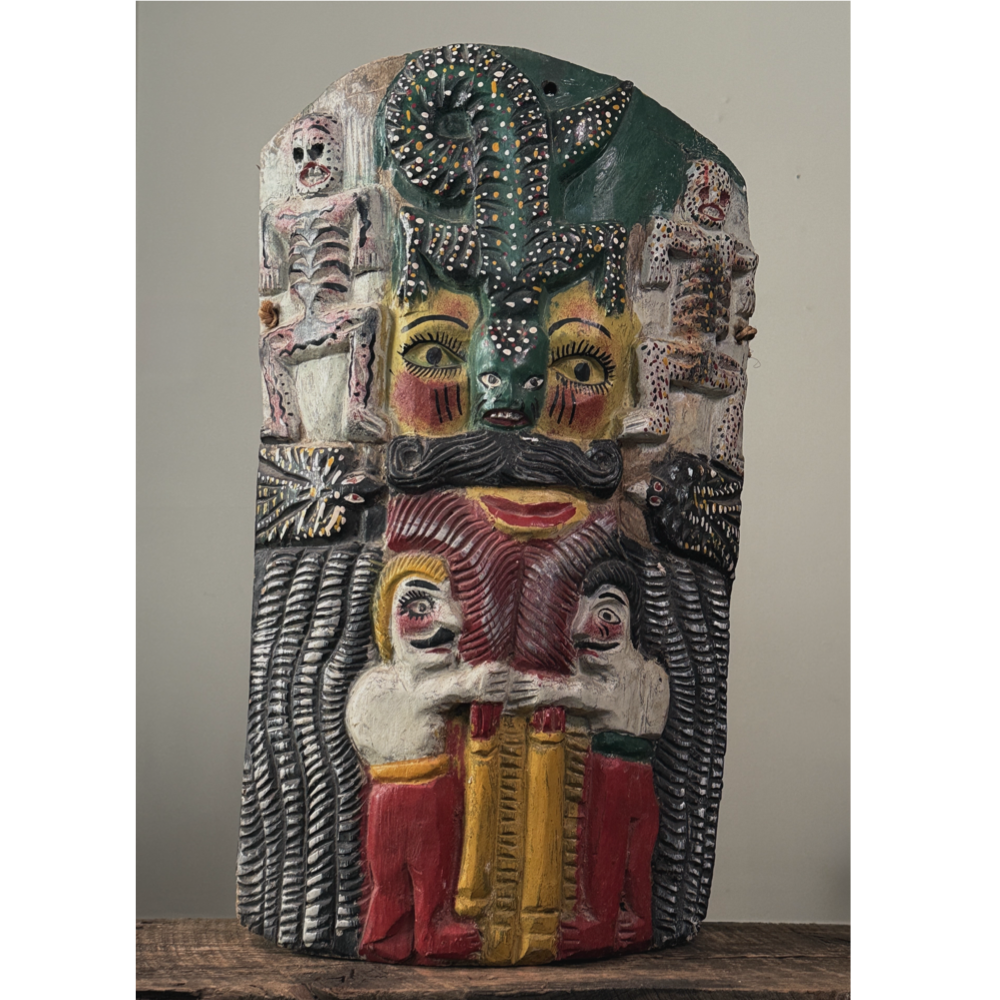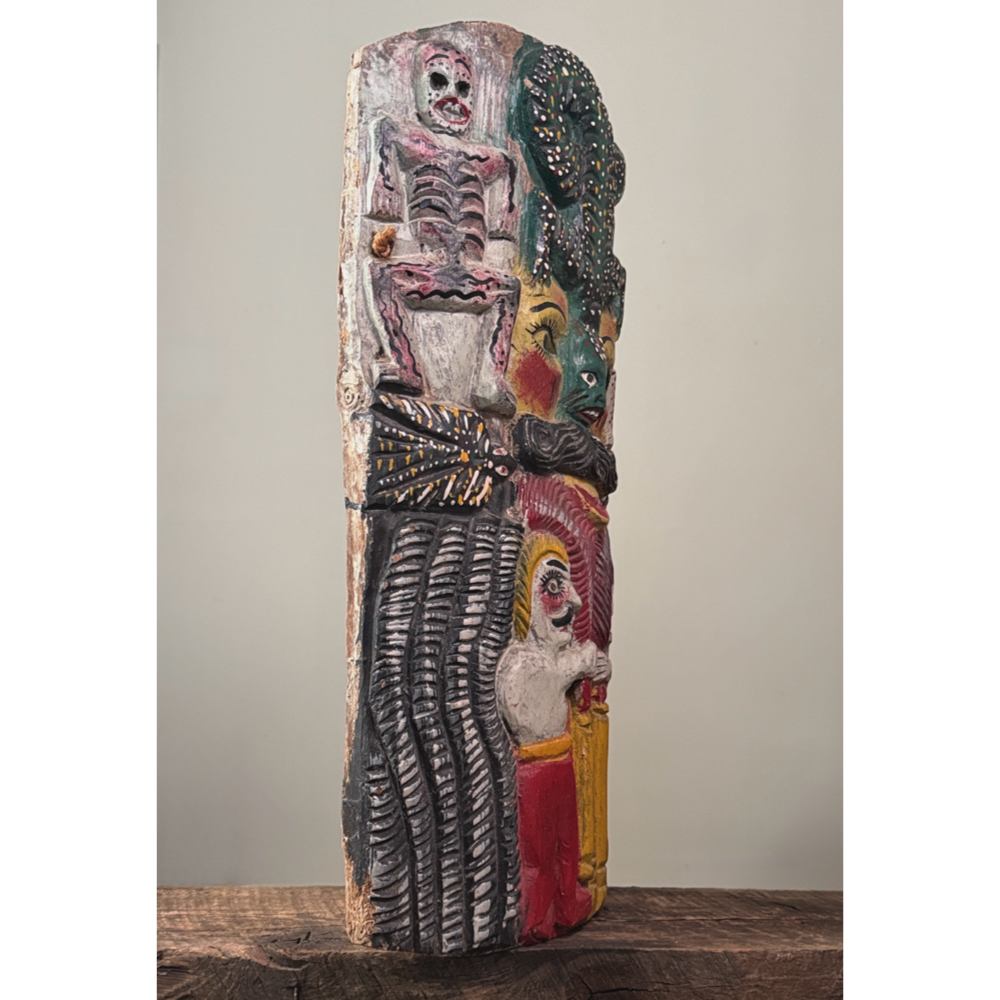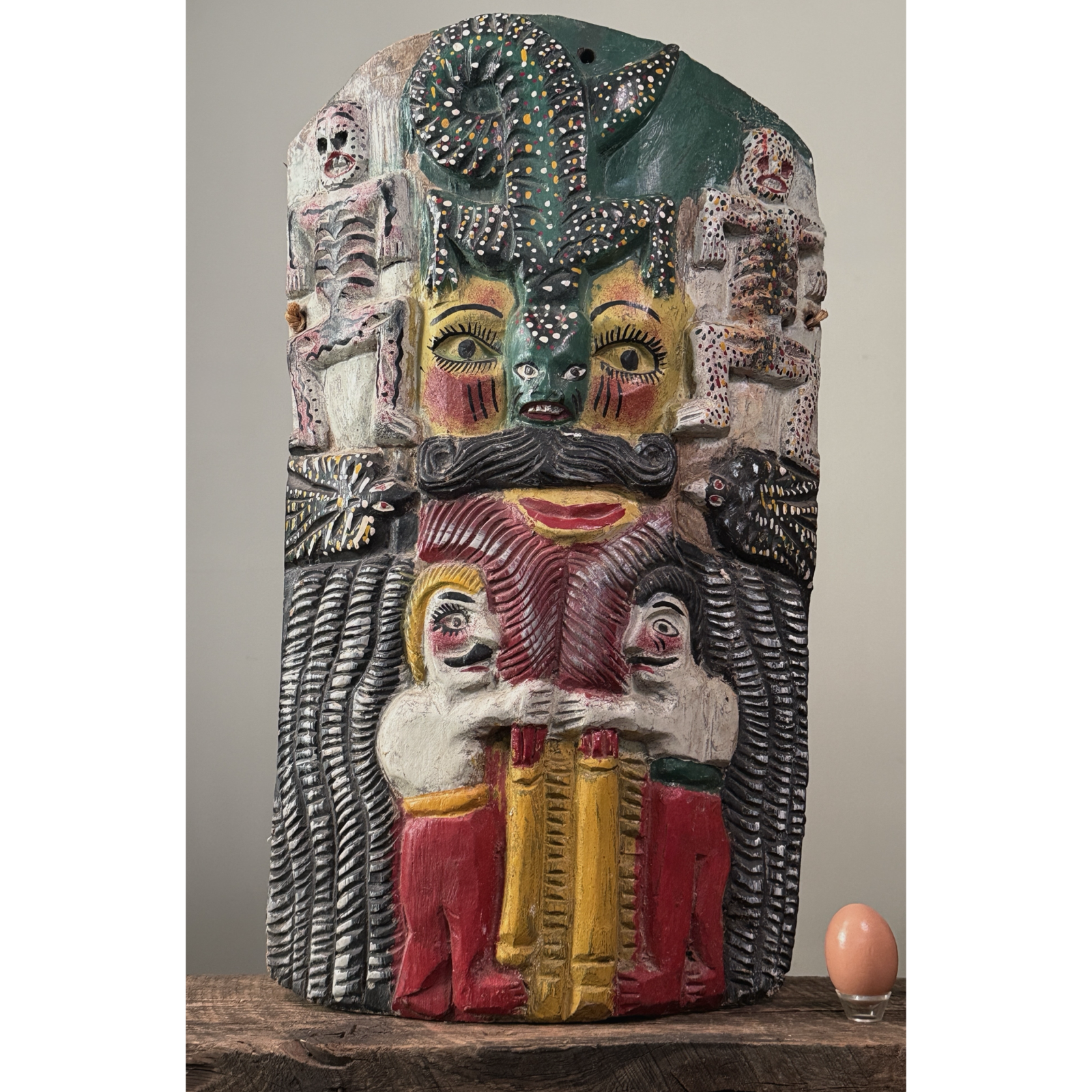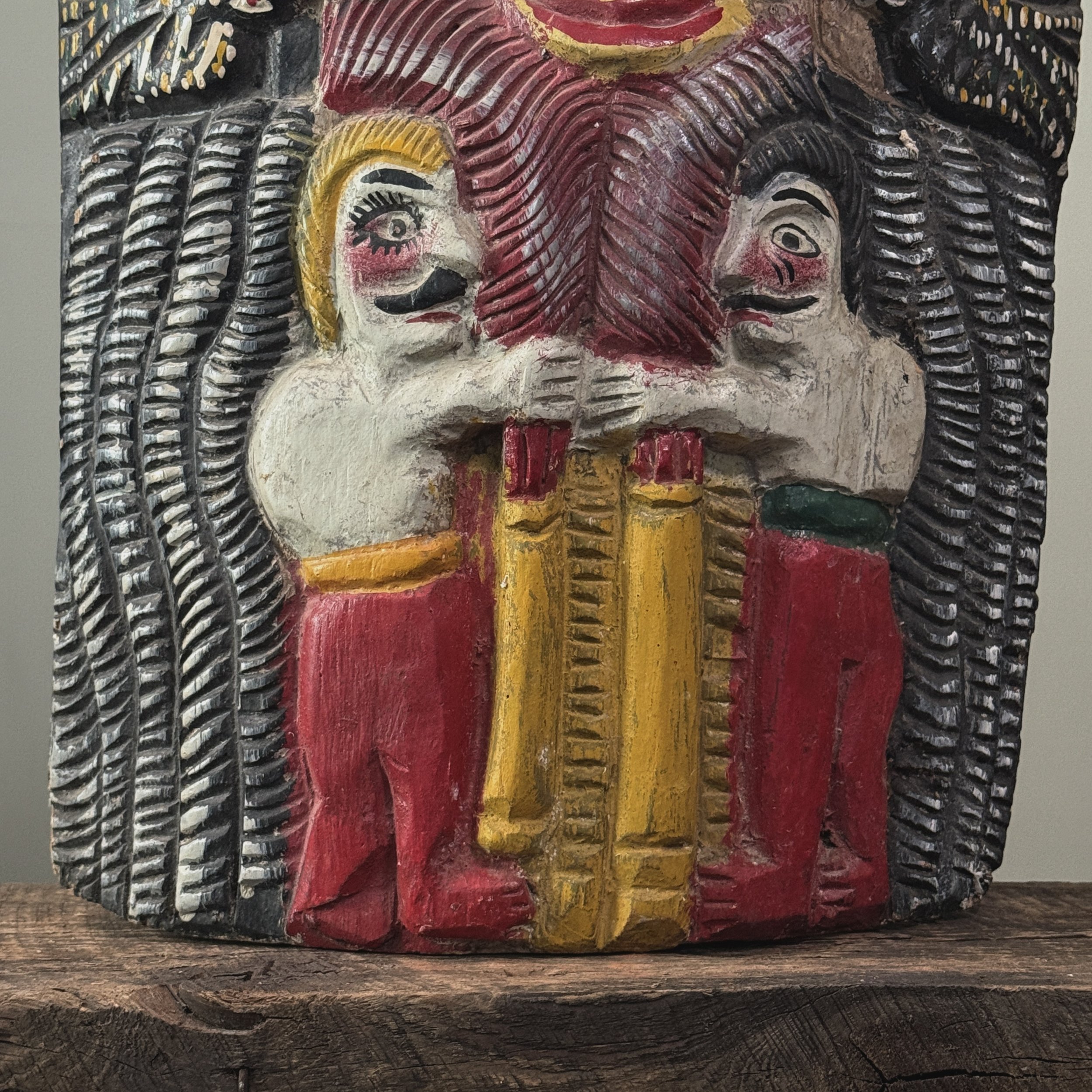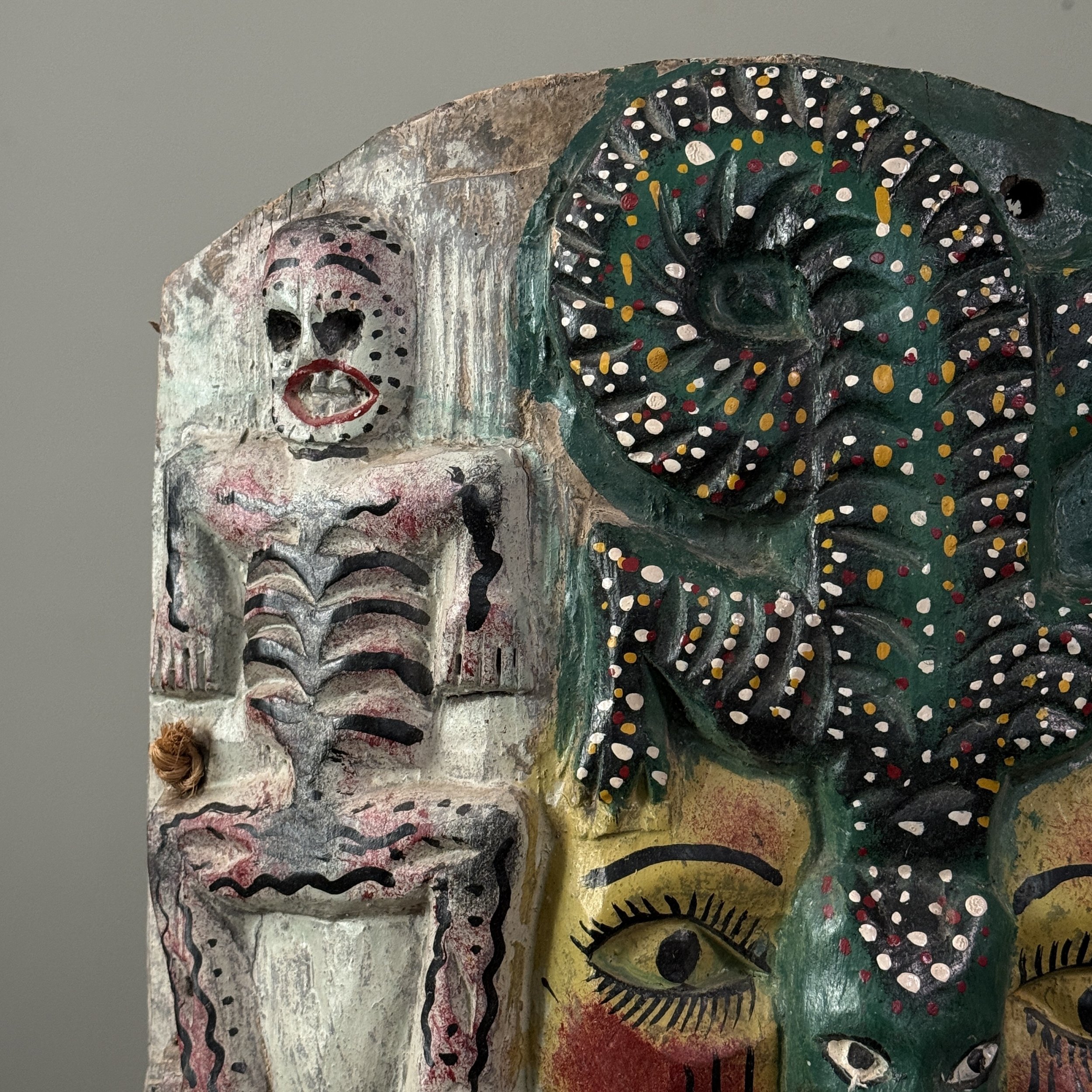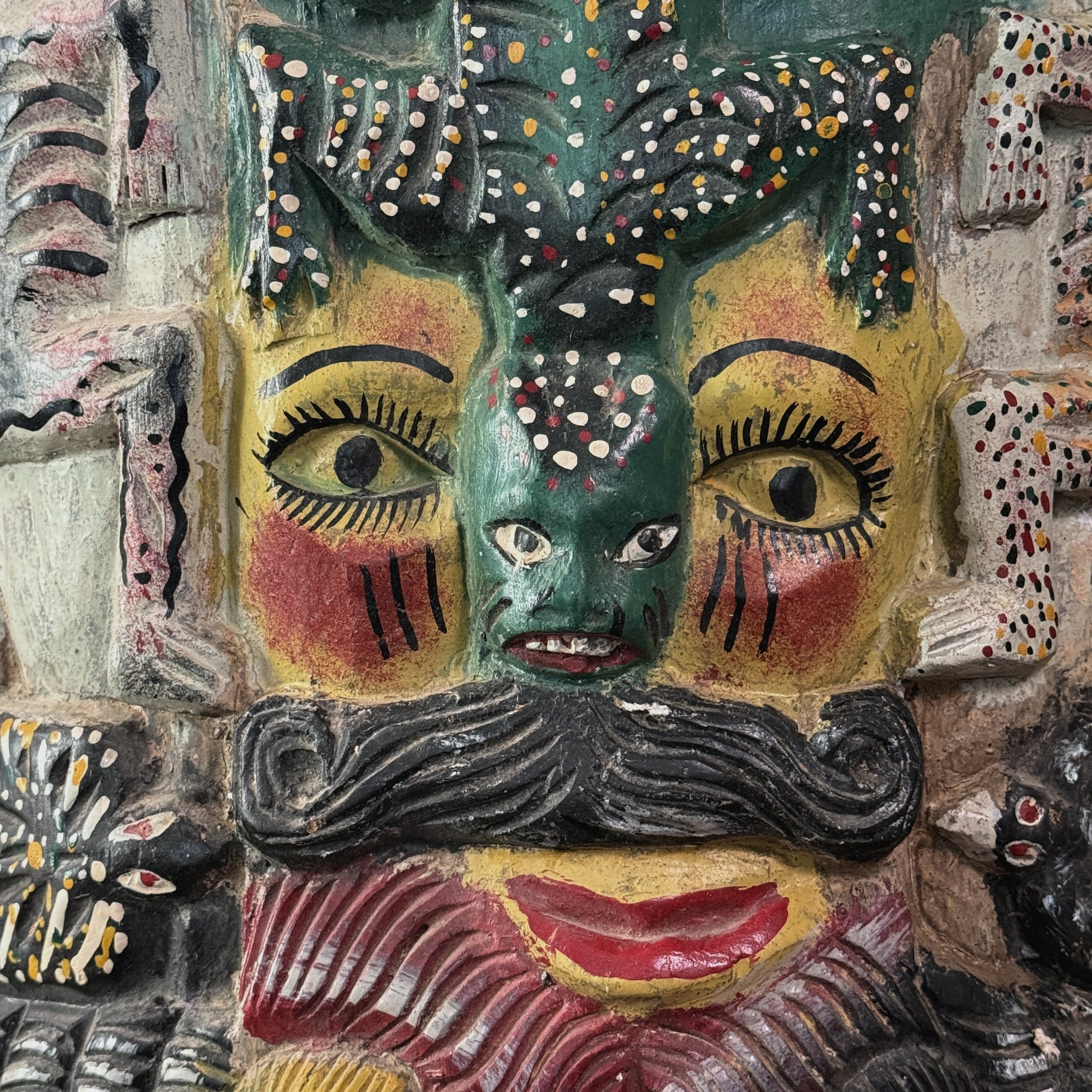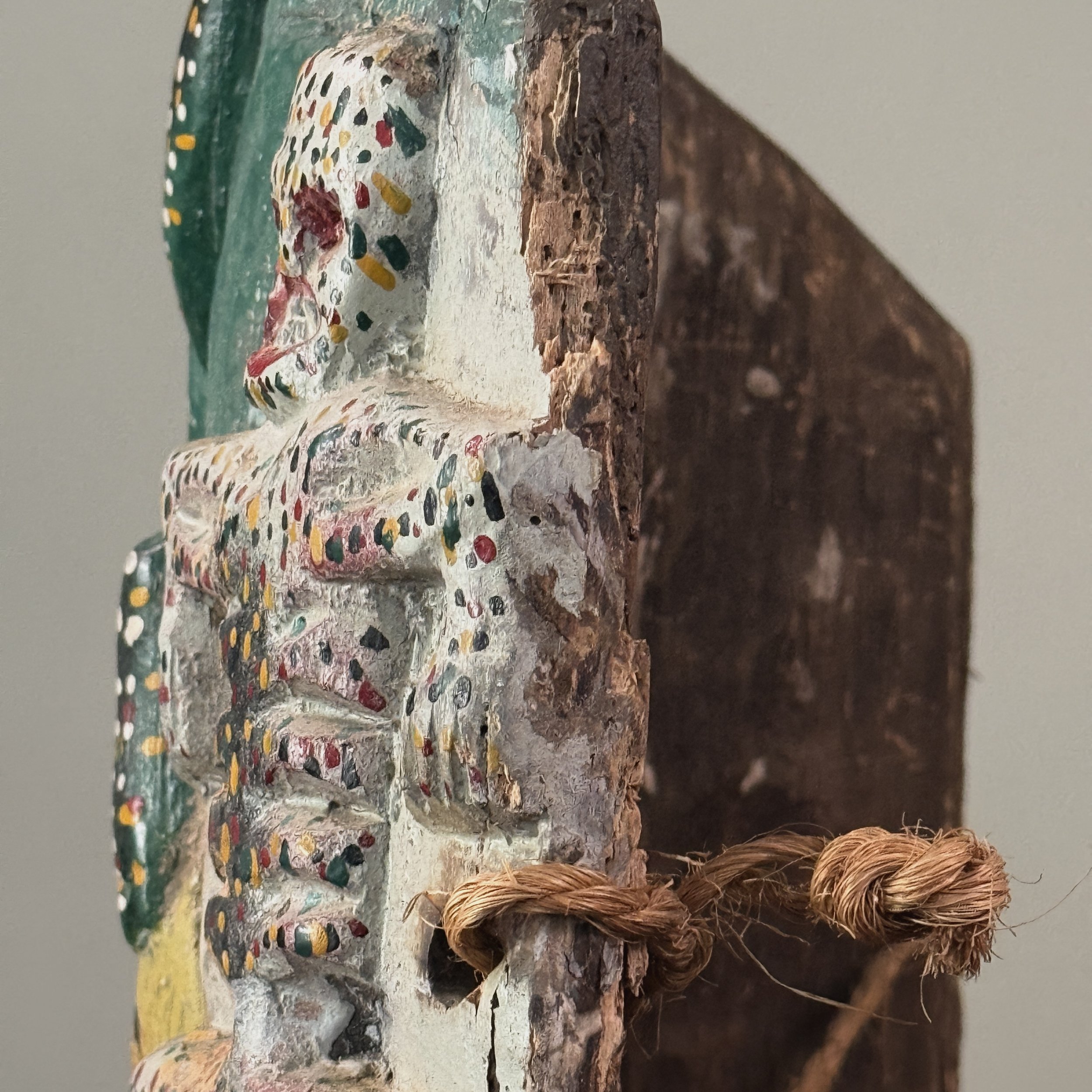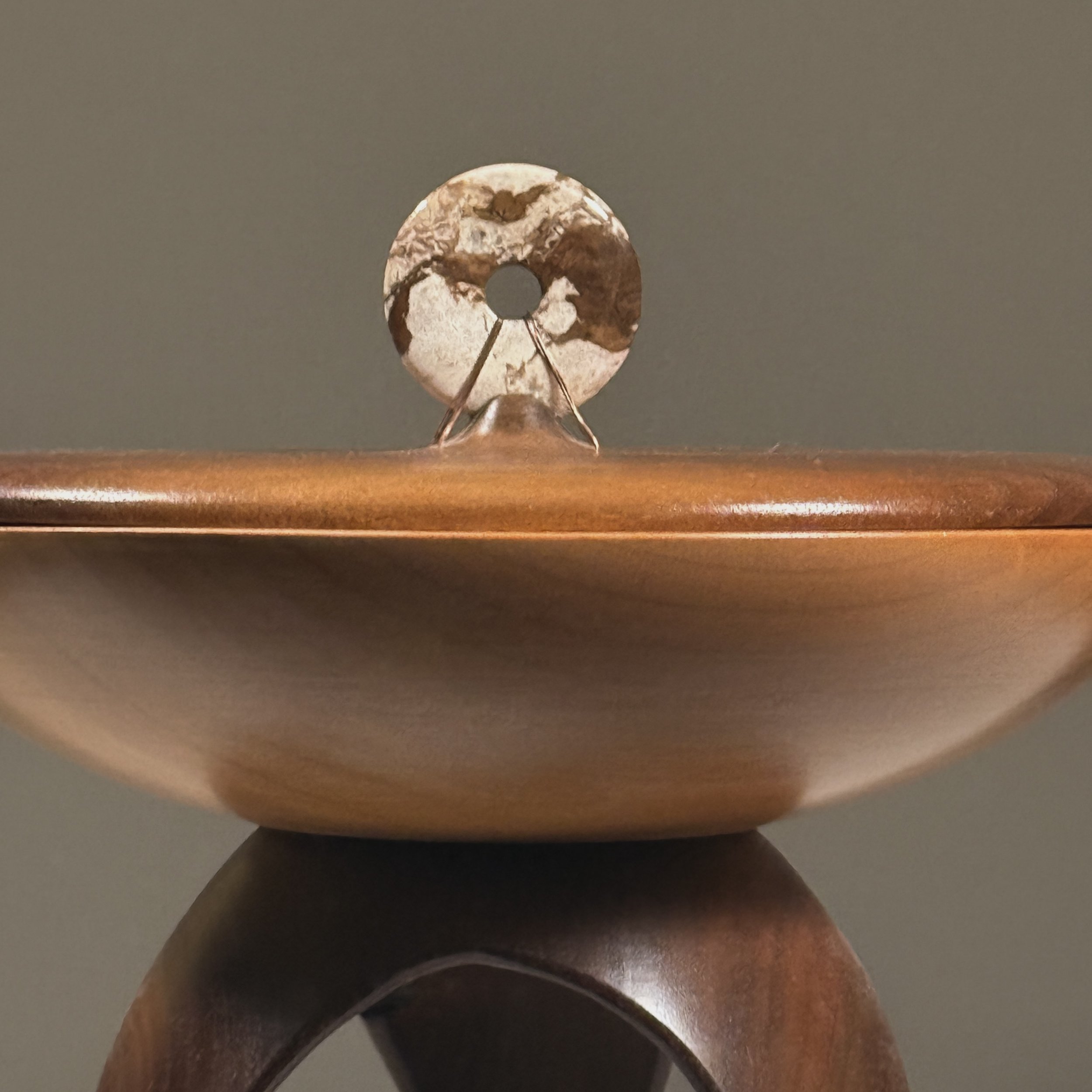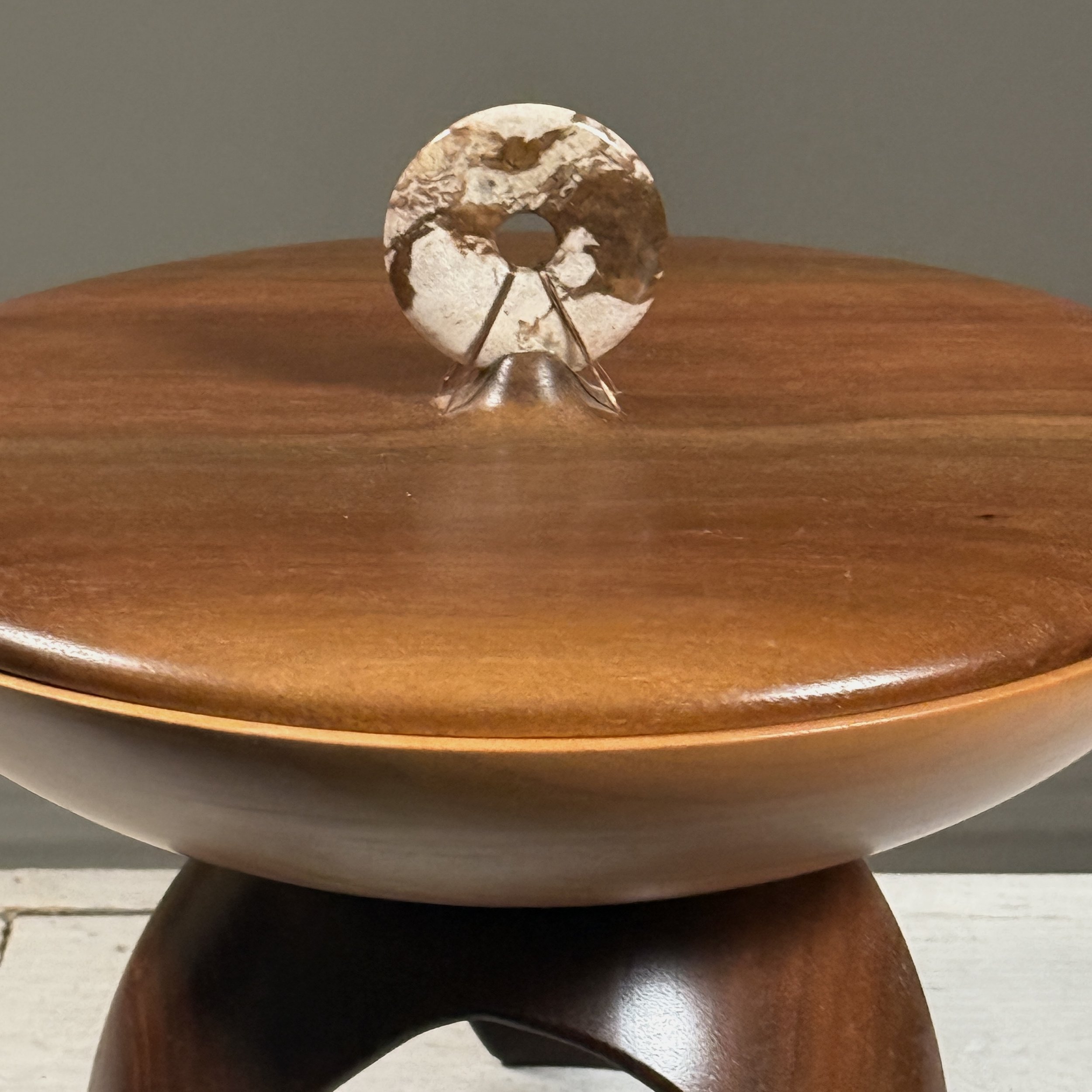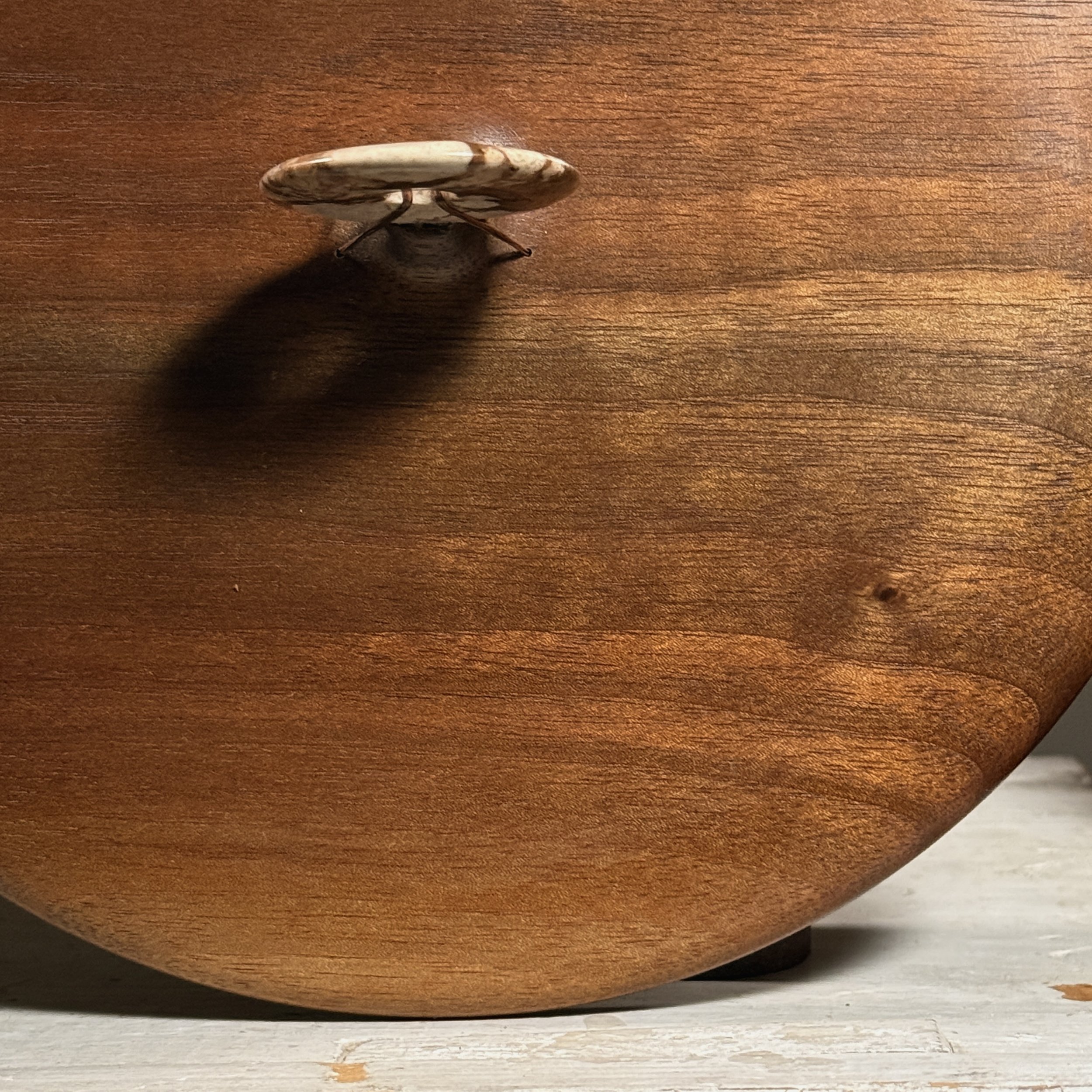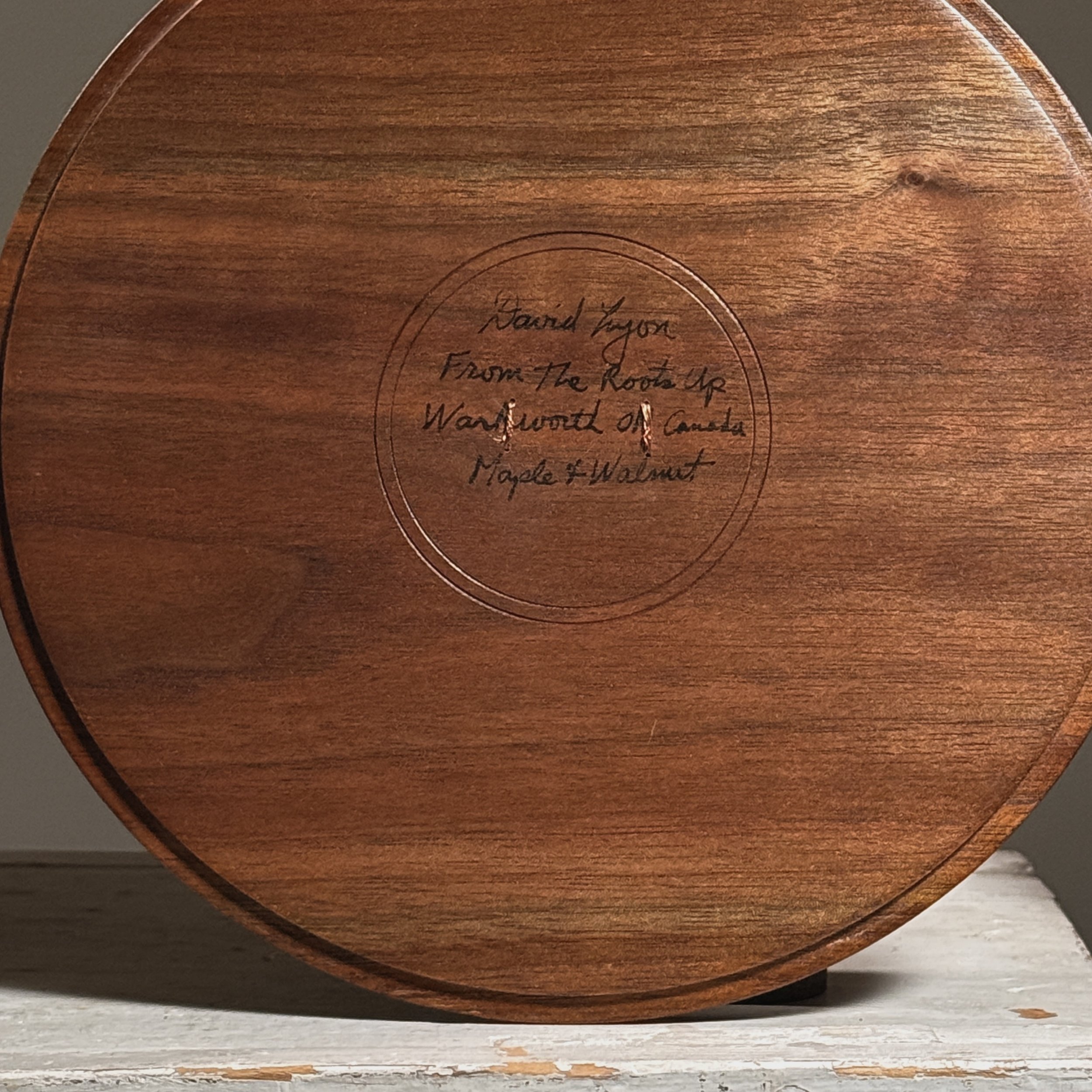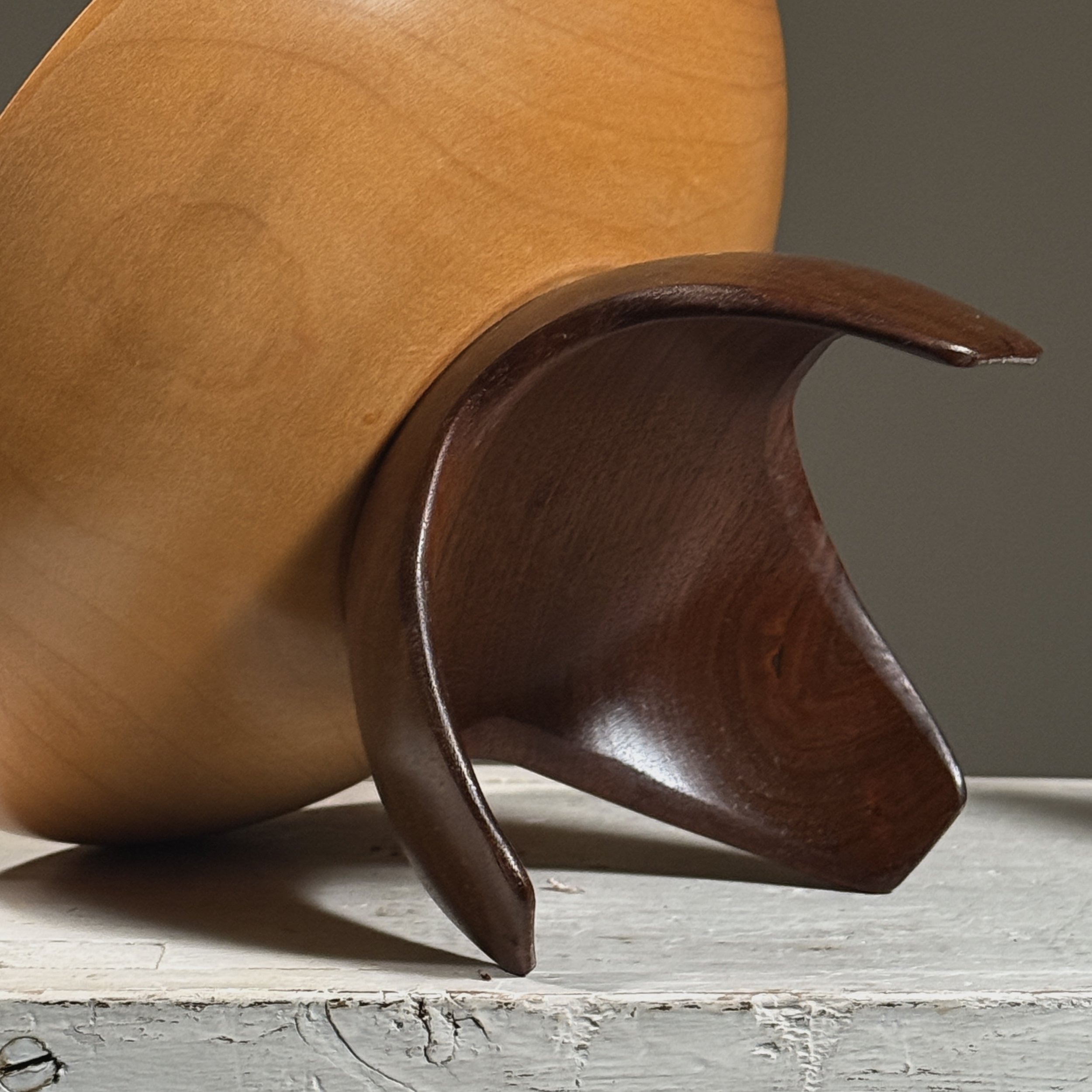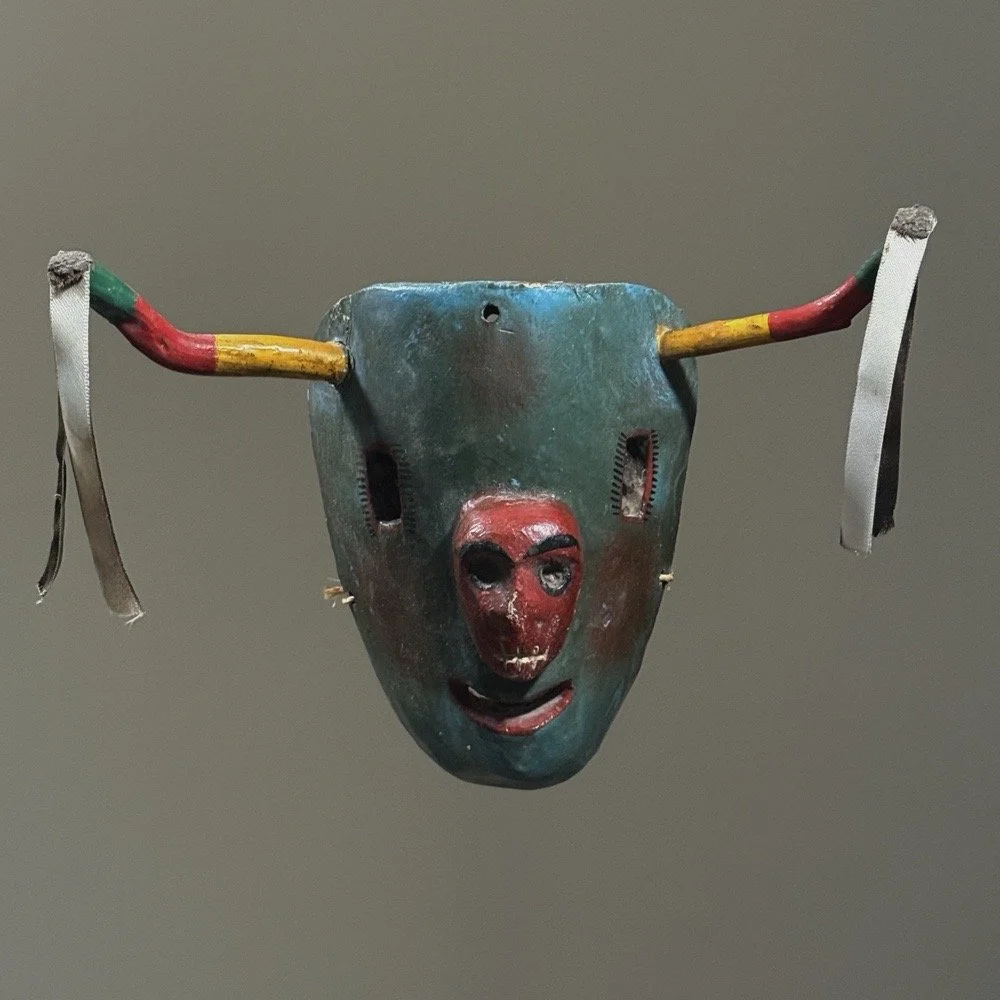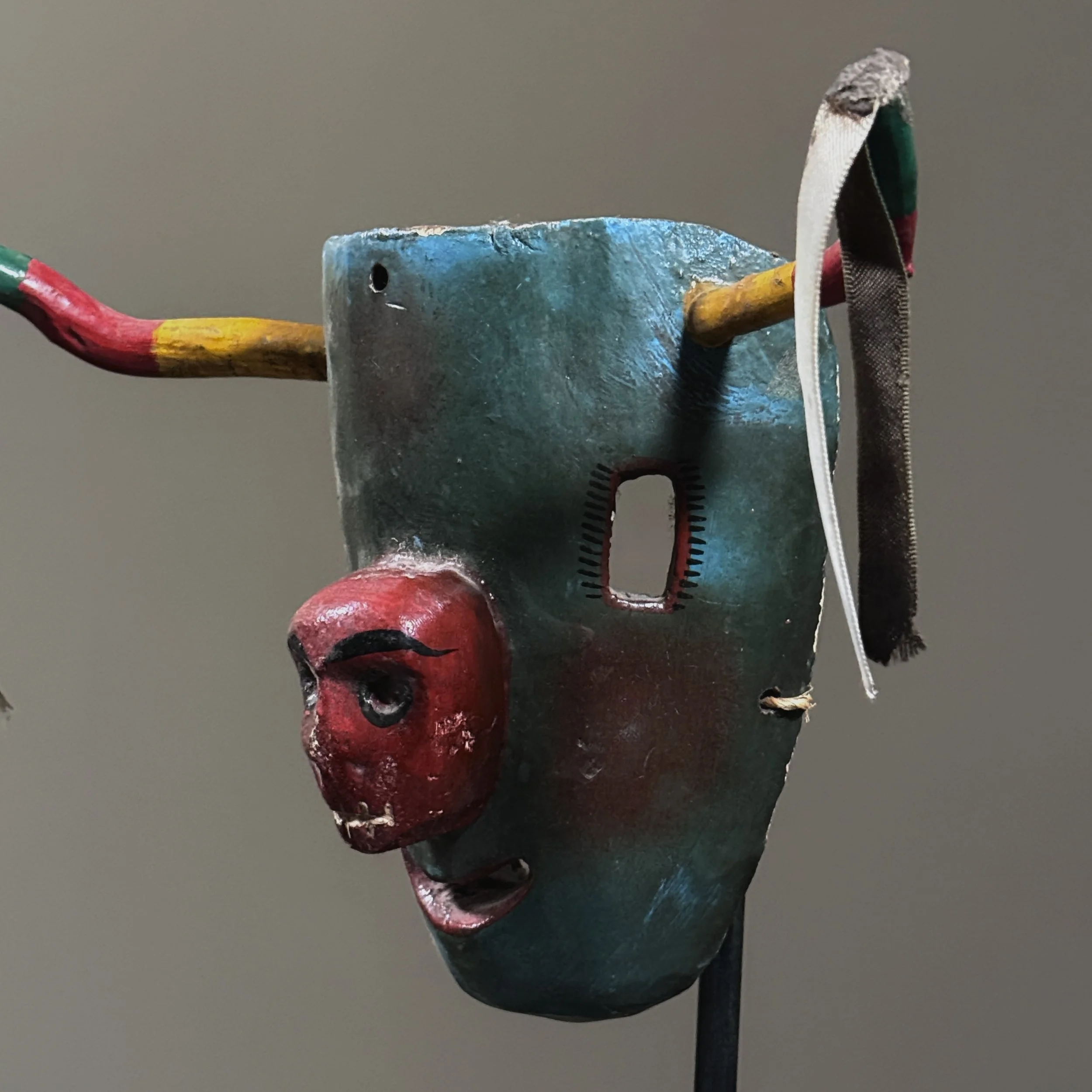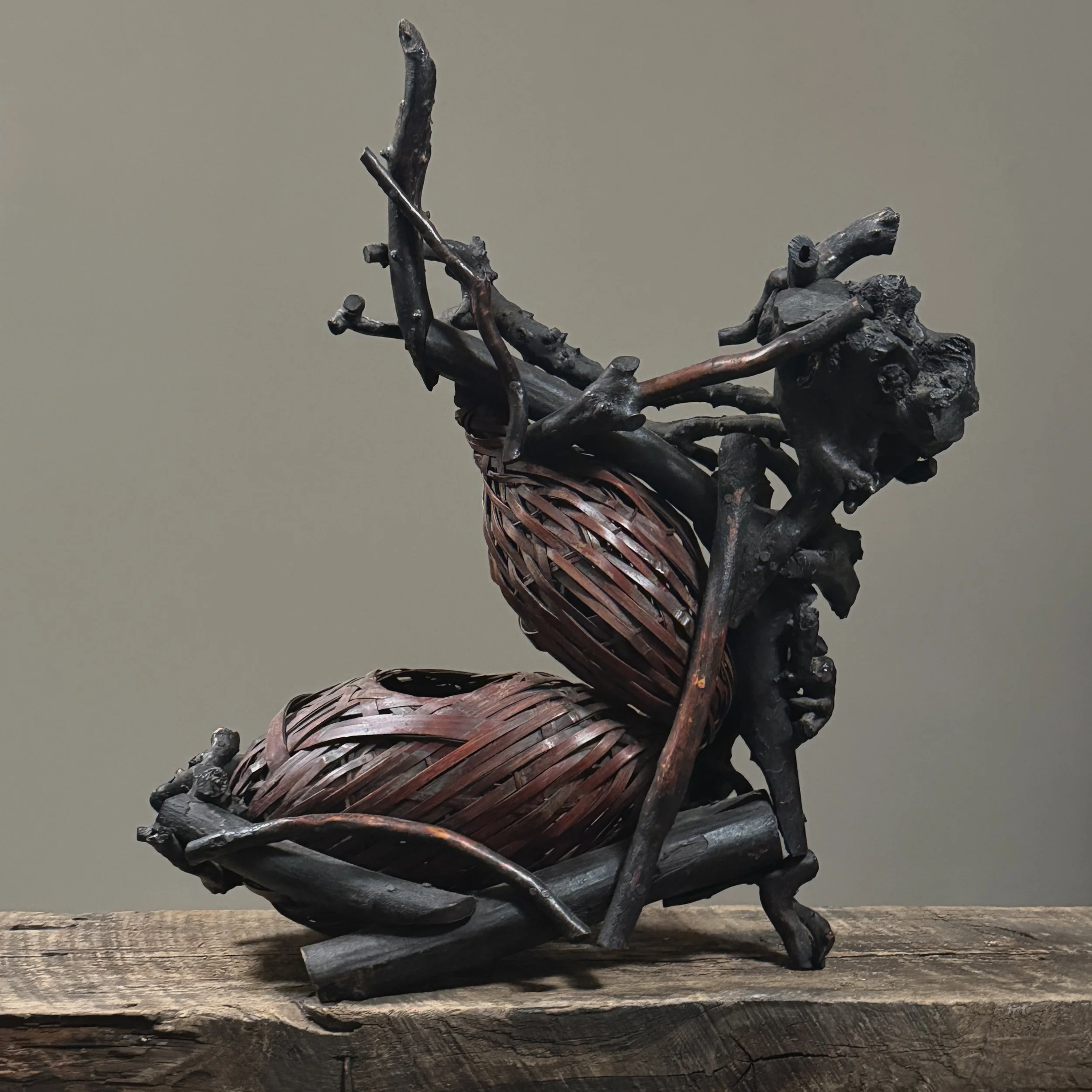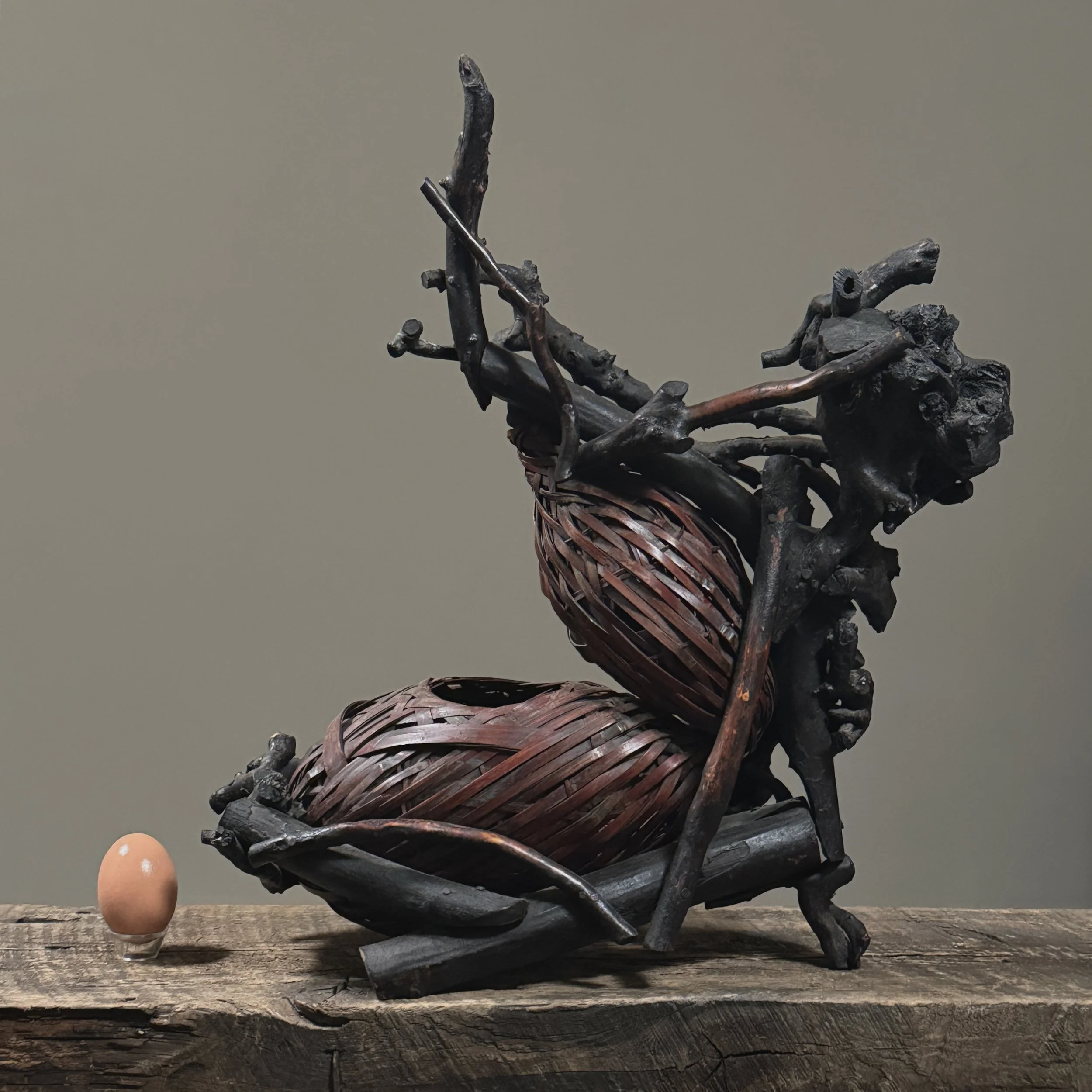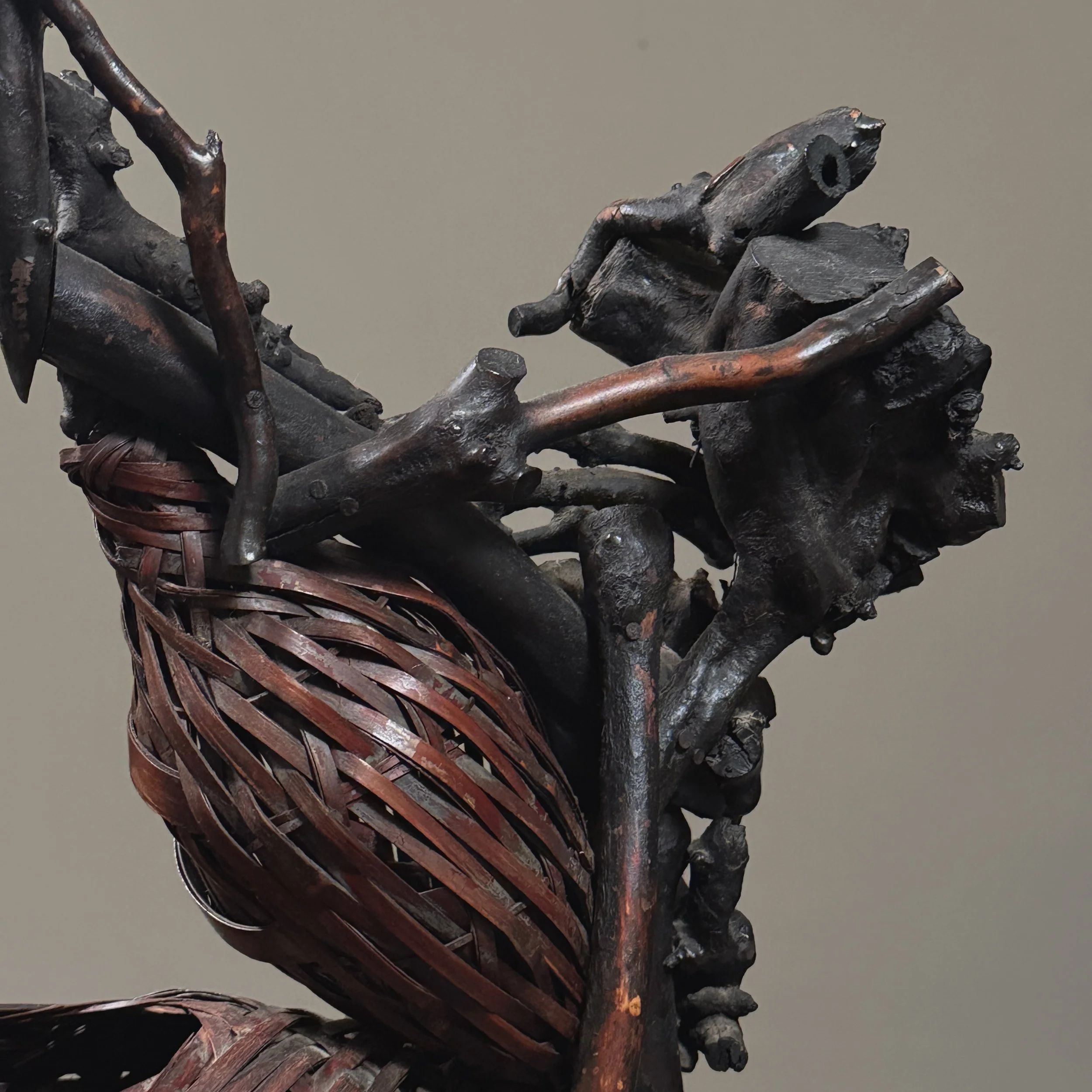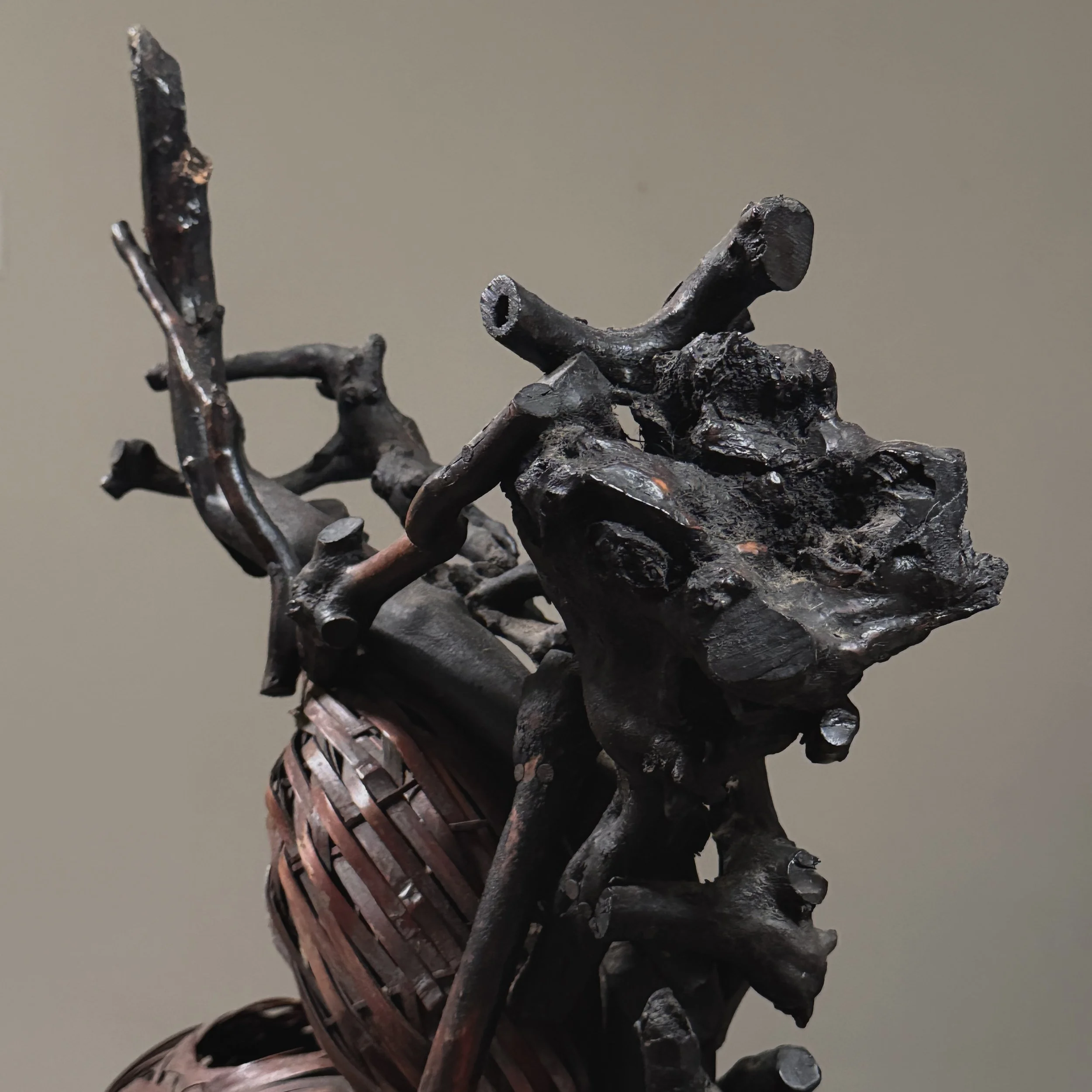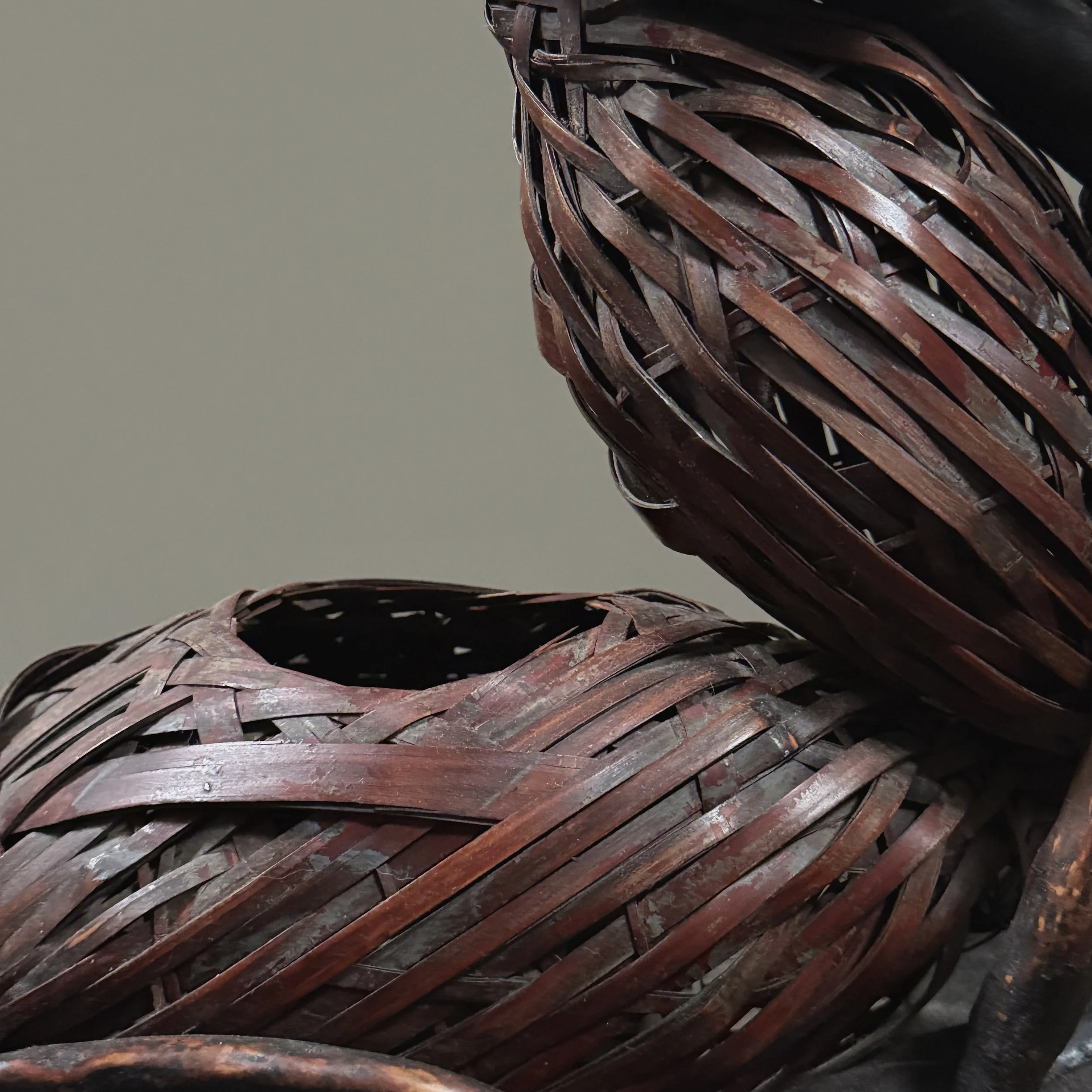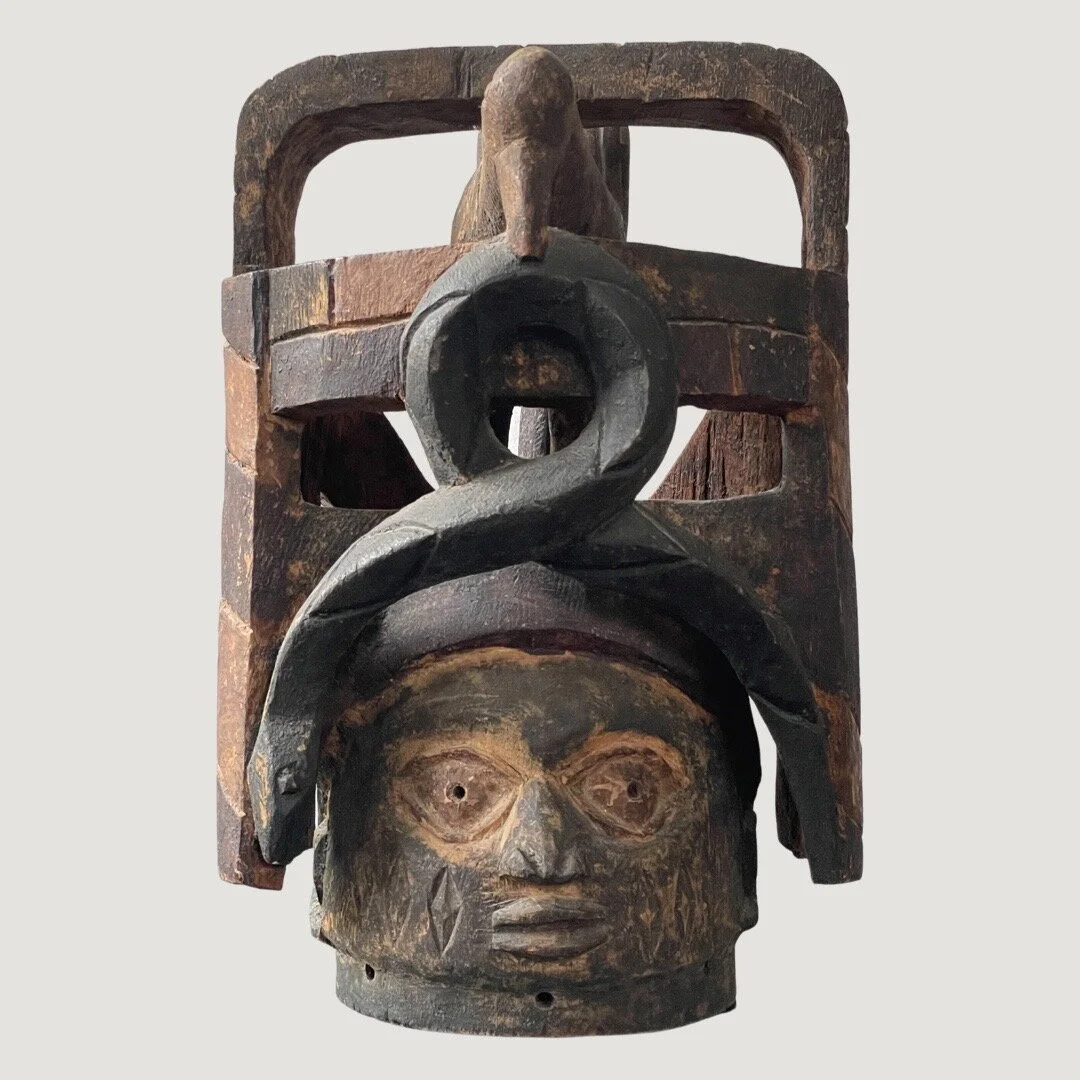 Image 1 of 13
Image 1 of 13

 Image 2 of 13
Image 2 of 13

 Image 3 of 13
Image 3 of 13

 Image 4 of 13
Image 4 of 13

 Image 5 of 13
Image 5 of 13

 Image 6 of 13
Image 6 of 13

 Image 7 of 13
Image 7 of 13

 Image 8 of 13
Image 8 of 13

 Image 9 of 13
Image 9 of 13

 Image 10 of 13
Image 10 of 13

 Image 11 of 13
Image 11 of 13

 Image 12 of 13
Image 12 of 13

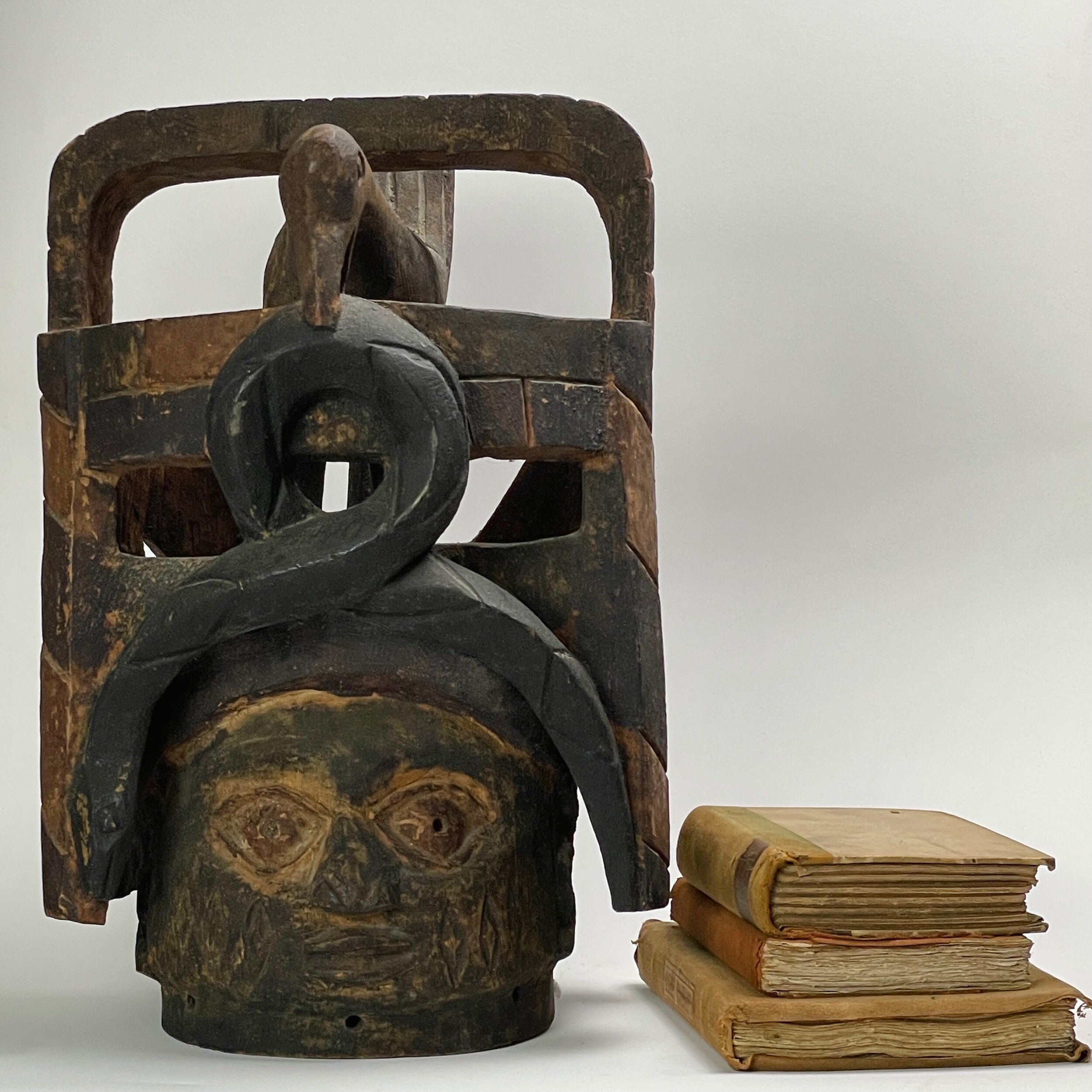 Image 13 of 13
Image 13 of 13














Antique African (Yoruba) Hand Carved Gelede Mask With Snake and Bird
Antique Yoruba Hand Carved Gelede Mask With Snake and Bird.
Size: 16”H x 11”D x 12”W
Condition is worn with patina and wear conducive with age.
If shopping outside of the US, please contact the store for a shipping quote.
This Gelede wooden mask is intricately carved from a single piece of wood. Three scarification diamonds incised on both cheeks. These scarification lines are called pele, which many communities in south-western Yorubaland regard as ‘gems’ on the human face. Holes along the base are where the mask is attached to the costume for the dance.
The upper part of the headdress is decorated with a bird holding a snake in its mouth. The snake curls around the beak and then are limp on both side of the face. The body of the snake is incised with triangular and diamond motifs. The head of the snake is not raised, but positioned in sympathy with the human face. There is a second bird that sits on the back of the mask with wings spread wide.
Snakes are generally associated with positive forces in African art. As opposed to the Western negative symbolism in art, snakes are presented with transformative and creative powers. Snakes are among the animals that often provide the most useful associations and comparisons to human situations in much African lore and symbolism.
The Yoruba people have three major festivals at which such headdresses are used: The Efe/Gelede but also the Egungun and the Epa/Elefon ceremonies.
The western Yoruba people practice the Efe/Gelede cult to celebrate the mystical power (ashe) of elderly women. Traditionally, they believe that the older women possess the power that can be used for creative or destructive purposes. Witchcraft, for example, is a destructive power used to bring about misfortune. The mystical power of elderly women is believed to be guiding the fundamental social existence.
In view of the spiritual power attributed to Yoruba women, Gelede headdresses commonly pay tribute to priestesses and female devotees of various gods. Gelede masked performance is a way of sustaining life through creating a social bond with the elderly women, who are generally referred to as ‘our mothers’ (awon iya wa). By having pleased ‘our mothers’, there will be peace in the community and the land will be blessed by rain and fertile soil.
The Gelede festival is widely celebrated in south-western Nigeria and is thought to have its origins in the late eighteenth century. It usually takes place in the main marketplace, and at the time of vegetative renewal, between March and May, when the rains arrive. The Gelede masked performance involves carefully choreographed dance, with pairs of men wearing similar headdresses and elaborate costumes masquerade as women to honor and entertain “our mothers”.
During the performance, each pair of dancers comes forward in turn and moves in intricate dance steps towards the drum rhythm. They dance in duet in swift jerky movements that resemble movements of birds and animals. Drumming and singing are essential features of the performance.
The headdresses are worn at an angle on top of the head. They are often carved in two parts, with the lower part often the form of a human face and the upper part with either an elaborate coiffure or a depiction of human activity. The human face is often a woman with static expression, which amplifies the contrast of the vitality and diversity of the elaborate structure on the top. The headdresses are kept in a hut in the compound of one of the society members.
The Gelede dancers are men. They are clad in layers of multicoloured cloths and a costume that emphasises the full breasts, narrow waist and buttocks of a beautiful and graceful woman. The identity of the dancer is not hidden as his face can be seen through the transparent cloth worn over the face. Unlike many other masked performances, the dancers are allowed to unmask in public. Dancer’s name may be given in the song which accompanies his act, making him the subject of praise or criticism for his performance. The harmony and balance shown by good dancers symbolise social perfection. Gelede dancers also perform whenever a member of the society dies.
Today, the Yoruba people form one of the largest tribes in west Africa. They number around 30 million and are predominant in Nigeria where they comprise 21 per cent of the population. Most Yoruba speak the Yoruba language. Today, 60 per cent are Christian and another 30 per cent are Muslim. But many, especially in rural areas, still practise old Yoruba traditions such as those based around.
Antique Yoruba Hand Carved Gelede Mask With Snake and Bird.
Size: 16”H x 11”D x 12”W
Condition is worn with patina and wear conducive with age.
If shopping outside of the US, please contact the store for a shipping quote.
This Gelede wooden mask is intricately carved from a single piece of wood. Three scarification diamonds incised on both cheeks. These scarification lines are called pele, which many communities in south-western Yorubaland regard as ‘gems’ on the human face. Holes along the base are where the mask is attached to the costume for the dance.
The upper part of the headdress is decorated with a bird holding a snake in its mouth. The snake curls around the beak and then are limp on both side of the face. The body of the snake is incised with triangular and diamond motifs. The head of the snake is not raised, but positioned in sympathy with the human face. There is a second bird that sits on the back of the mask with wings spread wide.
Snakes are generally associated with positive forces in African art. As opposed to the Western negative symbolism in art, snakes are presented with transformative and creative powers. Snakes are among the animals that often provide the most useful associations and comparisons to human situations in much African lore and symbolism.
The Yoruba people have three major festivals at which such headdresses are used: The Efe/Gelede but also the Egungun and the Epa/Elefon ceremonies.
The western Yoruba people practice the Efe/Gelede cult to celebrate the mystical power (ashe) of elderly women. Traditionally, they believe that the older women possess the power that can be used for creative or destructive purposes. Witchcraft, for example, is a destructive power used to bring about misfortune. The mystical power of elderly women is believed to be guiding the fundamental social existence.
In view of the spiritual power attributed to Yoruba women, Gelede headdresses commonly pay tribute to priestesses and female devotees of various gods. Gelede masked performance is a way of sustaining life through creating a social bond with the elderly women, who are generally referred to as ‘our mothers’ (awon iya wa). By having pleased ‘our mothers’, there will be peace in the community and the land will be blessed by rain and fertile soil.
The Gelede festival is widely celebrated in south-western Nigeria and is thought to have its origins in the late eighteenth century. It usually takes place in the main marketplace, and at the time of vegetative renewal, between March and May, when the rains arrive. The Gelede masked performance involves carefully choreographed dance, with pairs of men wearing similar headdresses and elaborate costumes masquerade as women to honor and entertain “our mothers”.
During the performance, each pair of dancers comes forward in turn and moves in intricate dance steps towards the drum rhythm. They dance in duet in swift jerky movements that resemble movements of birds and animals. Drumming and singing are essential features of the performance.
The headdresses are worn at an angle on top of the head. They are often carved in two parts, with the lower part often the form of a human face and the upper part with either an elaborate coiffure or a depiction of human activity. The human face is often a woman with static expression, which amplifies the contrast of the vitality and diversity of the elaborate structure on the top. The headdresses are kept in a hut in the compound of one of the society members.
The Gelede dancers are men. They are clad in layers of multicoloured cloths and a costume that emphasises the full breasts, narrow waist and buttocks of a beautiful and graceful woman. The identity of the dancer is not hidden as his face can be seen through the transparent cloth worn over the face. Unlike many other masked performances, the dancers are allowed to unmask in public. Dancer’s name may be given in the song which accompanies his act, making him the subject of praise or criticism for his performance. The harmony and balance shown by good dancers symbolise social perfection. Gelede dancers also perform whenever a member of the society dies.
Today, the Yoruba people form one of the largest tribes in west Africa. They number around 30 million and are predominant in Nigeria where they comprise 21 per cent of the population. Most Yoruba speak the Yoruba language. Today, 60 per cent are Christian and another 30 per cent are Muslim. But many, especially in rural areas, still practise old Yoruba traditions such as those based around.

